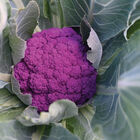Purple Moon (F1) Cauliflower Seed
Purple Moon (F1) Cauliflower Seed
Exceptionally early purple cauliflower.
Be the first to market with purple cauliflower! Very attractive, medium-dark, purple heads. Our best-performing purple variety in warm weather and also makes an excellent fall crop. Widely adapted.Specs:
SCIENTIFIC NAME:
Brassica oleraceaCULTURE:
Cauliflower prefers a well-drained, fertile soil high in organic matter with a pH of 6.0–7.5 and consistent moisture throughout the growing season. Irrigate regularly for best results. Cauliflower does not do well in hot weather; the best success is with spring and fall crops.DAYS TO MATURITY: From date of transplanting.TRANSPLANTING:
Early spring crop: Use early and midseason varieties. Sow in 72-cell plug flats. Seedlings should be ready to transplant in 4–6 weeks. If possible, keep soil at least 70°F (21°C) until germination, and 60°F (16°C) thereafter. Transplant outdoors when seedlings are no older than 4–5 weeks old. Older plants tend to be stressed and do not perform as well as actively growing seedlings. Harden plants carefully by gradually increasing cold before transplanting out, 18" between plants and 24–36" between rows. Fall crop: Use midseason and storage varieties. Start seedlings as above in May and transplant to the garden in June/July. To ensure mature heads, seed the crop early in areas where heavy freezes occur early in fall. Winter crop: Successful cauliflower crops can be grown where winters are mild (temperatures rarely below 32°F (0°C)). Transplants can be set out from September to February in these regions.DIRECT SEEDING:
Sow 3–4 seeds 18" apart, ½" deep, rows 24–36" apart, thinning to one plant in each group.BLANCHING:
Exposure to the sun can cause white cauliflower heads to yellow. To prevent yellowing and promote better head quality in hot weather, follow this blanching technique: at the moment when small white heads are just visible through leaves, gather the outer leaves over the head and tie with string or a large rubber band to preserve white curd color. Another method is to crack the leaf midribs and fold them over the heads until completely covered. Be sure not to break the leaves, or they may blow away. Tied or covered heads may experience increased humidity and greater likelihood of contracting Alternaria. As such, practice blanching only when necessary; not in the cool, shorter days of fall, or with colored varieties that need sunlight to achieve their full color.INSECT PESTS:
Repel flea beetles and root maggots on young seedlings by covering with floating row covers from day of planting. Treat flea beetles with insecticides such as pyrethrin or azadirachtin if heavy pressure is observed. For cabbage worms and loopers, use bacillus thuringiensis (bt). cutworm prevention: cultivate soil 24 weeks before planting to work in cover crops and destroy weeds.DISEASE:
Adhere strictly to a preventive program including: (1) long crop rotations with non-brassica crops, (2) clean starting mixes and outdoor seedbeds, and (3) strict sanitation practices. Johnny's Selected Seeds only sells seed lots of cauliflower that have tested negative for black rot (Xanthomonas campestris pv. campestris) and black leg (Phoma lingam). NOTE: A disease-free test result means that in the sample tested, the pathogen targeted was not found. It does not guarantee a seed lot to be disease-free. However, no method of seed treatment can positively insure freedom from disease. We are glad to help with specific questions.HARVEST:
Keep an eye on development, cutting heads when desired size is obtained but before the curds becomes loose, or "ricey."STORAGE:
Store at 32°F (0°C) and 95–98% relative humidity for 2–3 weeks.SIZED SEEDS:
"Sized" seeds have been sorted so they are roughly the same size. This consistency allows for more accurate spacing with mechanical seeders and more even germination. Cauliflower seeds are sized, except when noted in the product description.SEEDS/LB.:
84,000-164,400 (Avg. 105,800).PACKET:
100 seeds, unless otherwise noted.Johnny's is committed to your success, every step of the way.
We want you, our customer, to be 100% satisfied with all of our seeds, tools, and supplies.
If anything you purchase from us proves unsatisfactory, we will either replace the item or refund the purchase price.






